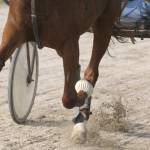Shockwave Therapy for Tendon Injuries in Horses: The Good and the Bad

Fifty years ago, the standard treatment for tendon injuries was a period of turnout. The best advice suggested an extensive period of inactivity, usually at least a year.
Today, great strides have been made in healing tendon injuries more quickly and with better outcomes in which scar tissue is minimized and properly aligned tendon fibers are encouraged. However, one important thing hasn’t changed: it still takes a long time for tendon tissue to mend.
Shockwave treatments use high-frequency sound waves to apply vibration to the healing tissues. The treatment is usually conducted several times at intervals of one to two weeks. There usually are no negative side effects, but the treatment can still lead to an unexpected situation.
A rapidly achieved result is significantly diminished pain. Increased blood flow and enhanced cellular transport to the injured area, results that support accelerated healing, don’t happen as quickly, and this disparity in timing can cause problems. The horse may feel so good that he exercises energetically, causing more injury. Similarly, the owner may see the horse moving without pain, assume that complete healing has taken place, and resume training.
Though treatment techniques have changed, several months are required for damaged tissues to heal completely. Working the horse too hard in the interim is likely to aggravate the injury and slow recovery. If your horse has been diagnosed with a tendon injury, work closely with a veterinarian who can determine how much healing has taken place and advise as to how much exercise the horse can safely tolerate.








